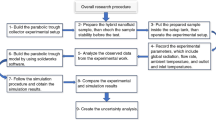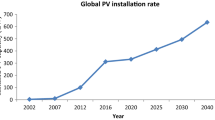Abstract
A new model based on electric circuit theory has been introduced for modeling the radon exhalation from water to air in a sample bottle. Comparing the differential equations for radon exhalation from water to air and a hybrid electrical circuit shown that the volume of water or air, radon concentration, radon flux and solubility coefficient (dependent on temperature of water) are equivalent with capacitance, voltage across of capacitor, current and voltage gain, respectively. Then by using a hybrid electrical model total radon transfer velocity from water to air and time variation of water radon concentration in our experimental setup has been obtained. Also the variations of air radon concentration with temperature, volume of water and volume of air is obtained. The results show a good agreement with those in literatures.









Similar content being viewed by others
References
Schmidt A, Schlueter M, Melles M, Schubert M (2008) Continuous and discrete on-site detection of radon-222 in ground-and surface waters by means of an extraction module. Appl Radiat Isot 66:1939–1944
Freyer K, Treutler HC, Dehnert J, Nestler W (1998) Sampling and measurement of radon-222 in water. J Environ Radioact 37:327–337
Papastefanou C (2002) An overview of instrumentation for measuring radon in soil gas and groundwater. J Environ Radioact 63:271–283
Mathieu GG, Biscaye PE, Lupton RA, Hammond DE (1988) System for measurement of Rn-222 at low-levels in natural-waters. Health Phys 55:989–992
Schubert M, Bürkin W, Peña P, Lopez A, Balcázar M (2006) On-site determination of the radon concentration in water samples: methodical background and results from laboratory studies and a field-scale test. Radiat Meas 41:492–497
Moldovan M, Cosma C, Encian I, Dicu T (2009) Radium-226 concentration in Romanian bottled mineral waters. J Radioanal Nucl Chem 279:487–491
Smetanová I, Holý K, Müllerová M, Polášková A (2010) The effect of meteorological parameters on radon concentration in borehole air and water. J Radioanal Nucl Chem 283:101–109
Burnett WC, Kim G, Lane-Smith D (2001) A continuous radon monitor for assessment of 222Rn in coastal ocean waters. J Radioanal Nucl Chem 249:167–172
Burnett WC, Dulaiova H (2003) Estimating the dynamics of groundwater input into the coastal zone via continuous radon-222 measurements. J Environ Radioact 69:21–35
Lee JM, kim G (2006) A simple and rapid method for analyzing radon in coastal and ground waters using a radon-in-air monitor. J Environ Radioact 89:219–228
Schwarzenbach RP, Gschwend PM, Imboden DM (1993) Environmental Organic Chemistry. John Wiley & Sons, New York
Whitman WG (1923) The two-film theory of gas absorption. Chem Metal Eng 29:146–148
Liss PS, Slater PG (1974) Flux of gases across the air-sea interface. Nature 247:181–184
Igarashi G, Tohjima Y, Wakita H (1993) Time-variable response characteristics of groundwater radon to earthquakes. Geophys Res Lett 20:1807–1810
Calugaru DG, Crolet JM (2002) Identification of radon transfer velocity coefficient between liquid and gaseous phases. Comptes Rendus Mecanique 330:377–382
Weigel F (1978) Radon Chem Ztg 102:287–299
Higuchi T, Igarashi G, Tohjima Y, Wakita H (1995) Time series analysis of groundwater radon using stochastic differential equations. J Phys Earth 43:117–130
Author information
Authors and Affiliations
Corresponding author
Rights and permissions
About this article
Cite this article
Musavi Nasab, S.M., Negarestani, A. & Mohammadi, S. Modeling of the radon exhalation from water to air by a hybrid electrical circuit. J Radioanal Nucl Chem 288, 813–818 (2011). https://doi.org/10.1007/s10967-011-1003-4
Received:
Published:
Issue Date:
DOI: https://doi.org/10.1007/s10967-011-1003-4




